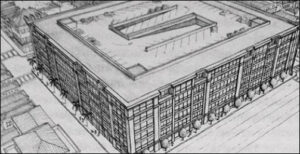One more angle to think about when appraising Amazon’s HQ2 project in Arlington… A single developer, JBG Smith, will have a disproportionate impact on the evolution of the urban fabric in the National Landing district of Arlington and Alexandria. In theory, a single big developer can mobilize more resources, carry out better planning and execute a more uniform standard of design than could an uncoordinated army of small builders.
Not so fast. Over on the Strong Towns blog, Daniel Herriges compares “Texas donut” approach typical of Dallas, Texas – a monumental ediface consuming an entire city block — with the incremental approach of traditional development in Charleston, S.C.
“Incremental development doesn’t mean slow, small, or cautious. Incremental means many hands,” Herriges writes. “The ‘increment of development’ is how big each project is, but says nothing about how many projects are taking place.
He continues:
It’s a truism that the invisible hand of the market—or call it the emergent wisdom of the crowd, if you’re averse to “market” rhetoric; they’re the same thing—makes better decisions than any individual or small group in power, no matter how visionary they may be. You know those experiments where a crowd is asked to guess the number of gumballs in a jar, and when their guesses are averaged, they get it right to astonishing precision? Even though no one person’s guess is that close?
2,000 small-scale developers can produce emergent answers to questions like, “How much housing does this city need?”, “What’s the right mix of commercial and residential?”, or “What’s the right mix of single-family and multi-family housing?” 20 big developers, on the other hand, will likely misjudge to some extent.
Definitely something to think about.




